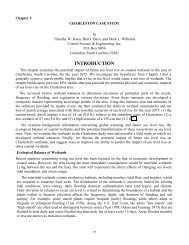A GEM Detector System for an Upgrade of the CMS Muon Endcaps
A GEM Detector System for an Upgrade of the CMS Muon Endcaps
A GEM Detector System for an Upgrade of the CMS Muon Endcaps
Create successful ePaper yourself
Turn your PDF publications into a flip-book with our unique Google optimized e-Paper software.
instrumented with <strong>GEM</strong>s, <strong>the</strong> number <strong>of</strong> detectors needed <strong>for</strong> <strong>CMS</strong> could be several 100’s. For such qu<strong>an</strong>tities,<br />
<strong>the</strong> time <strong>an</strong>d certainly <strong>the</strong> cost <strong>of</strong> <strong>the</strong> detector production becomes <strong>an</strong> issue.<br />
One <strong>of</strong> <strong>the</strong> most time-consuming <strong>an</strong>d labor-intensive part <strong>of</strong> Triple-<strong>GEM</strong> detector production is <strong>the</strong> <strong>GEM</strong> foil<br />
stretching <strong>an</strong>d <strong>the</strong> gluing <strong>of</strong> <strong>the</strong> spacer frames. In <strong>an</strong> attempt to avoid <strong>the</strong>se steps <strong>an</strong>d speed up <strong>the</strong> production<br />
process, a novel assembly procedure was tested in 2011, here referred to as <strong>the</strong> “self-stretching” technique. The<br />
procedure is demonstrated in Fig. 31 showing a few photographs taken during <strong>the</strong> assembly <strong>of</strong> <strong>the</strong> first 10 cm ×<br />
10 cm “<strong>CMS</strong> Proto III” Triple-<strong>GEM</strong> prototype at CERN using this new technique.<br />
(a) (b)<br />
(c) (d)<br />
(e) (f)<br />
Figure 31: The self-stretching Triple-<strong>GEM</strong> assembly technique: (a) <strong>GEM</strong> foil be<strong>for</strong>e assembly; (b) external frame<br />
<strong>for</strong> foil stretching; (c) mounting <strong>the</strong> <strong>GEM</strong> foils; (d) stretching <strong>the</strong> foils; (e) stretched <strong>GEM</strong>; (f) completed detector<br />
including readout board.<br />
The <strong>GEM</strong> foils are produced with a pattern <strong>of</strong> holes near <strong>the</strong> edge <strong>of</strong> each <strong>of</strong> <strong>the</strong> four sides <strong>of</strong> <strong>the</strong> foil. Using<br />
a special external frame that is placed around <strong>the</strong> assembly, <strong>the</strong> detector frames are pre-tensioned in such a way<br />
that <strong>the</strong>y slightly bow inwards. The foils are <strong>the</strong>n placed on a detector structure which has a set <strong>of</strong> alignment pins<br />
matching <strong>the</strong> hole pattern in <strong>the</strong> foil edges. After removal <strong>of</strong> <strong>the</strong> external frame, <strong>the</strong> <strong>GEM</strong> frame resumes its natural<br />
shaps <strong>an</strong>d <strong>the</strong> attached foils are stretched <strong>an</strong>d finally fixed with screws to <strong>the</strong> detector structure <strong>an</strong>d thus held in<br />
place. In <strong>the</strong> end, once <strong>the</strong> foils have been completely stretched <strong>an</strong>d fixed, <strong>the</strong> readout board c<strong>an</strong> be mounted,<br />
closing <strong>the</strong> detector.<br />
Clearly, compared to <strong>the</strong> st<strong>an</strong>dard assembly procedure, <strong>the</strong> self-stretching technique <strong>of</strong>fers m<strong>an</strong>y adv<strong>an</strong>tages. Nei<strong>the</strong>r<br />
gluing nor soldering is required during <strong>the</strong> assembly procedure <strong>an</strong>d, at least in <strong>the</strong> case <strong>of</strong> a small prototype,<br />
<strong>the</strong> detector c<strong>an</strong> be produced without <strong>the</strong> need to place <strong>an</strong>y spacers in <strong>the</strong> active area, i.e. in <strong>the</strong> gaps between <strong>the</strong><br />
foils. The technique is very fast; <strong>for</strong> example, <strong>the</strong> small prototype shown in Fig.31 was assembled in only one hour.<br />
As <strong>an</strong> additional benefit, this allows <strong>for</strong> <strong>the</strong> detector to be re-opened if needed in order to make modifications or<br />
repairs, or to replace a <strong>GEM</strong> foil.<br />
The small “<strong>CMS</strong> Proto III” prototype produced in this way was tested using <strong>an</strong> x-ray gun with a Cu target in <strong>the</strong><br />
RD51 lab. With <strong>an</strong> Ar/CO2 (70:30) gas mixture, <strong>the</strong> detector exhibited stable operation <strong>for</strong> a measured gain up to<br />
32
















